BuySellBA
Administrator
Wooden buildings: why Chile and Uruguay are beating Argentina, when Mass Timber can be used and what it is - La Nacion Propiedades

Source:
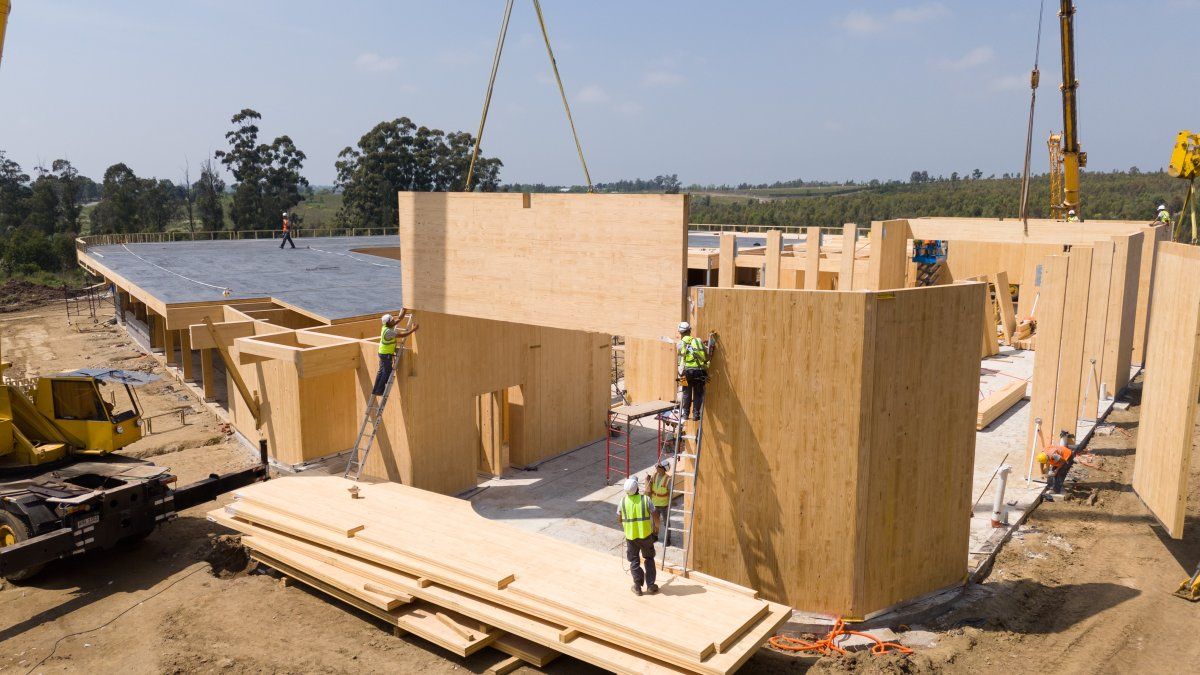
 www.ambito.com
www.ambito.com
August 06, 2025
By José Luis
Cross-laminated timber allows for the construction of homes with a lower environmental impact and high precision. How the system works and what's needed to advance it in the country.
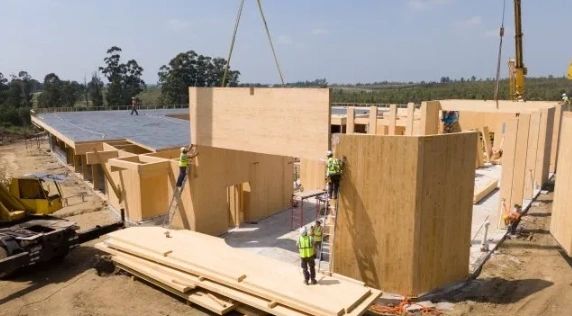
The Mass Timber system allows construction with prefabricated wooden pieces, ready to be assembled on site.
The Mass Timber system , also known as solid or cross-laminated timber , is advancing in Latin America as a sustainable, industrialized, and highly efficient construction alternative. This model allows for construction using prefabricated wood panels, which arrive ready to be assembled on-site. Countries such as Chile and Uruguay are leading the adoption of this technology in the region, while Argentina is seeking to close the gap.
Mass Timber is based on components such as Cross-Laminated Timber (CLT) and Glue-Laminated Timber (GLT), two engineered products that use structural timber laminated with high-strength adhesives. CLT is manufactured by bonding orthogonal layers of wood, providing rigidity and stability for walls, ceilings, and floors. GLT, on the other hand, consists of layers glued in one direction, ideal for long-span columns and beams.
Carlos Mazzey , manager of Mass Timber's Technical Office at Arboreal, explained that the main advantage of this system is its prefabrication: "Each piece is designed, machined, and adapted to the project's needs before arriving on site. This reduces assembly times and allows for cleaner, more precise, and lighter construction."
The use of wood as a structural material also represents an environmental breakthrough. Its manufacture requires less energy than concrete or steel, contributes to carbon storage, and reduces the emissions footprint. Therefore, this technology has been adopted in various countries as part of sustainable construction strategies.
In Argentina, interest in Mass Timber is growing, but its implementation is still in its infancy. Unlike Chile and Uruguay, where industrial plants operate to supply the domestic market, there is no active factory in the country producing CLT or GLT with international certification.
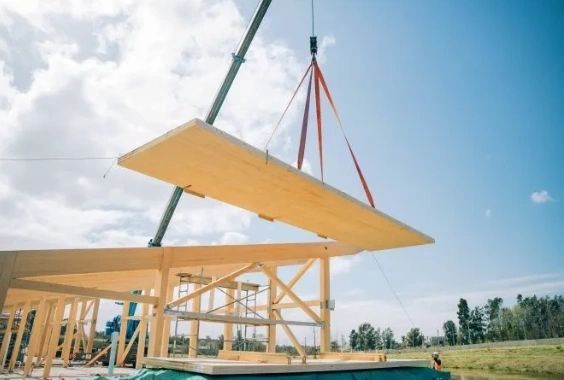
Construction in Canelones, Uruguay. CLT and GLT are the two most commonly used structural products in high-rise timber construction.
This gap limits the scale of developments and increases costs, as part of the system must be imported or the process outsourced.
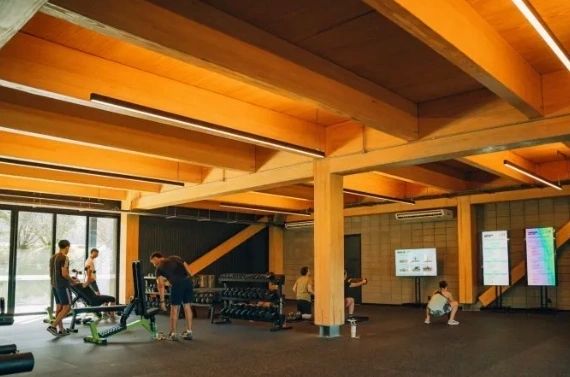
A sports center built with this system
As Mazzey explained, this vertical integration allows for the manufacture of custom parts for each project, from walls and floors to ceilings and load-bearing elements. "We work with architects and engineers from structural design to production. Each element arrives pre-cut, pre-drilled, and pre-milled, ready to be assembled," he indicated.
Arboreal participates in single-family housing projects, buildings, schools, sports centers, and hotels. It also exports to markets such as Brazil, Mexico, Chile, and the Dominican Republic.
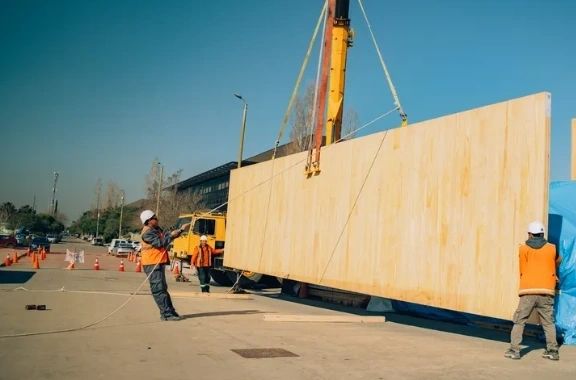
Paneling for interior and exterior finishes speeds up construction times
The assembly of an 80-square-meter home can be completed in a week by three people. The high level of industrialization and prior design allow the pieces to be assembled without any on-site cutting. Structural connections are defined from the outset of the project and are secured with metal screws and hardware, ensuring safety and speed of execution.
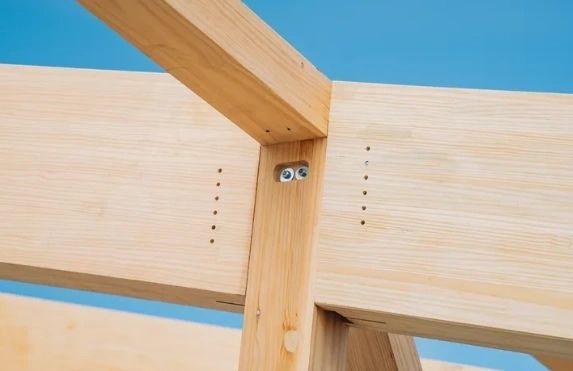
Robustness characterizes this system, which is spreading throughout the world, with Chile and Uruguay leading the way in South America. Argentina wants to adopt it soon.
In interiors, CLT or GLT panels can be left exposed. To achieve this, the design must consider aspects such as fire protection, installation clearance, junctions between rooms, and joint resolution. The system's versatility also allows for customized finishes, with aesthetic and technical criteria defined from the design perspective.
To achieve this, waterproofing and cross-ventilation solutions are applied. The dimensional stability of CLT and GLT, along with their thermal and acoustic properties, allows the structure to remain in good condition for decades, provided technical recommendations are followed.
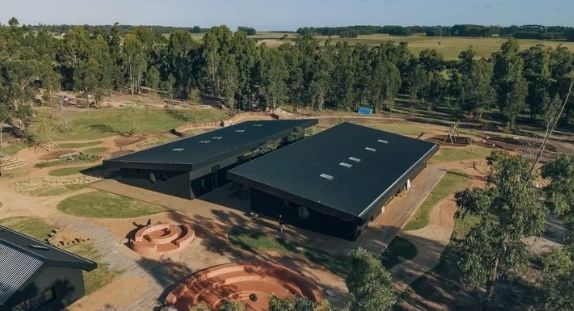
A private school completed in Uruguay
According to data from the Argentine Chamber of Wood (CADAMDA), building with wood reduces the environmental impact compared to other traditional systems. One square meter of steel-framed construction generates 40 kg of CO and consumes 143 kWh; with concrete, the figure is 27 kg and 80 kWh. In contrast, a wooden structure emits only 4 kg of CO and consumes 22 kWh.
Daniel Vier , president of CADAMDA, emphasized that wood is renewable, recyclable, and carbon-neutral. He also highlighted its thermal and acoustic insulation and humidity regulation capabilities, attributes that impact the comfort and energy efficiency of spaces.
In economic terms, the costs are not marginal either. According to CADAMDA, building with structural timber in Argentina today costs no less than US$1,700 per square meter, and can reach figures 60% higher in more sophisticated cases.
While the system offers advantages in terms of speed, precision, and waste reduction, Vier noted that the country must optimize the value chain and incentivize investment. "With a robust forestry industry, adequate regulations, and financing, wood can contribute to addressing the housing shortage and boosting regional economies," he said.
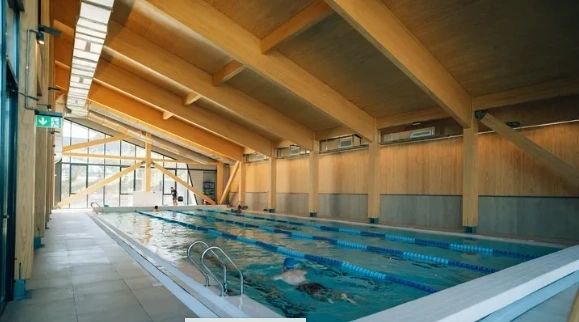
Swimming pool (located on the ground floor) of a solid wood building. The system's lightweight structure allows for load-bearing without reinforcing the foundation.
Mazzey noted that potential demand exists, especially in segments that value sustainability and speed of construction.
The advancement of structural timber as a construction system will also depend on policies that promote sustainable construction, incentives for developments with renewable components, and closer integration between design, engineering, and production.
In a context where cleaner, lighter, and faster alternatives are being sought to address the housing shortage, Mass Timber appears to be a concrete option. Chile and Uruguay demonstrate that it is possible to construct buildings from wood with quality, precision, and international standards.
In Argentina, the challenge is to transform this potential into installed capacity. Other Argentine construction companies have already built buildings of up to three stories in different parts of the country, from Patagonia (San Martín de los Andes and Villa La Angostura) to the Litoral, and there is growing interest in industrialized solutions with a smaller environmental footprint, according to industry sources. Higher buildings are expected to be built in the coming years.
www.buysellba.com
Source:

Edificios de madera: por qué Chile y Uruguay le ganan a la Argentina, cuándo podrá usarse el Mass Timber y qué es
La madera contralaminada permite levantar viviendas con menor impacto ambiental y alta precisión. Cómo funciona el sistema y qué falta para que avance en el país.
August 06, 2025
By José Luis
Cross-laminated timber allows for the construction of homes with a lower environmental impact and high precision. How the system works and what's needed to advance it in the country.

The Mass Timber system allows construction with prefabricated wooden pieces, ready to be assembled on site.
The Mass Timber system , also known as solid or cross-laminated timber , is advancing in Latin America as a sustainable, industrialized, and highly efficient construction alternative. This model allows for construction using prefabricated wood panels, which arrive ready to be assembled on-site. Countries such as Chile and Uruguay are leading the adoption of this technology in the region, while Argentina is seeking to close the gap.
Mass Timber is based on components such as Cross-Laminated Timber (CLT) and Glue-Laminated Timber (GLT), two engineered products that use structural timber laminated with high-strength adhesives. CLT is manufactured by bonding orthogonal layers of wood, providing rigidity and stability for walls, ceilings, and floors. GLT, on the other hand, consists of layers glued in one direction, ideal for long-span columns and beams.
Carlos Mazzey , manager of Mass Timber's Technical Office at Arboreal, explained that the main advantage of this system is its prefabrication: "Each piece is designed, machined, and adapted to the project's needs before arriving on site. This reduces assembly times and allows for cleaner, more precise, and lighter construction."
The use of wood as a structural material also represents an environmental breakthrough. Its manufacture requires less energy than concrete or steel, contributes to carbon storage, and reduces the emissions footprint. Therefore, this technology has been adopted in various countries as part of sustainable construction strategies.
In Argentina, interest in Mass Timber is growing, but its implementation is still in its infancy. Unlike Chile and Uruguay, where industrial plants operate to supply the domestic market, there is no active factory in the country producing CLT or GLT with international certification.

Construction in Canelones, Uruguay. CLT and GLT are the two most commonly used structural products in high-rise timber construction.
This gap limits the scale of developments and increases costs, as part of the system must be imported or the process outsourced.
What's happening in the region
Chile has a well-established forestry industry, with companies that mass-produce structural wood panels. Local regulations already allow for the use of these products in multi-story buildings and public projects. In Uruguay, Arboreal operates the largest Mass Timber plant in South America. Located in the department of Tacuarembó, it has its own sawmill, precision CNC (Computer Numerical Control) machinery (a technology that automates cutting and drilling using computers that precisely control the tools), and certifications that guarantee the structural quality of its products.
A sports center built with this system
As Mazzey explained, this vertical integration allows for the manufacture of custom parts for each project, from walls and floors to ceilings and load-bearing elements. "We work with architects and engineers from structural design to production. Each element arrives pre-cut, pre-drilled, and pre-milled, ready to be assembled," he indicated.
Arboreal participates in single-family housing projects, buildings, schools, sports centers, and hotels. It also exports to markets such as Brazil, Mexico, Chile, and the Dominican Republic.
Foundations and assembly
Homes built with Mass Timber require foundations similar to traditional ones. For single-story homes, concrete footings, slabs, or beams are used. In larger-scale construction, the material's lightness allows for reduced loads and optimized foundations, which can translate into lower costs.
Paneling for interior and exterior finishes speeds up construction times
The assembly of an 80-square-meter home can be completed in a week by three people. The high level of industrialization and prior design allow the pieces to be assembled without any on-site cutting. Structural connections are defined from the outset of the project and are secured with metal screws and hardware, ensuring safety and speed of execution.
Coatings and finishes
Exterior and interior finishes depend on the architectural design. One of the key factors in ensuring durability is humidity control. Facades must protect the wood from the elements with ventilation systems, breathable membranes, and solutions adapted to the local climate. In some cases, exterior cladding is applied with sheet metal, cement-based panels, or treated wood.
Robustness characterizes this system, which is spreading throughout the world, with Chile and Uruguay leading the way in South America. Argentina wants to adopt it soon.
In interiors, CLT or GLT panels can be left exposed. To achieve this, the design must consider aspects such as fire protection, installation clearance, junctions between rooms, and joint resolution. The system's versatility also allows for customized finishes, with aesthetic and technical criteria defined from the design perspective.
Maintenance and durability
Maintaining a house built with Mass Timber requires similar controls as other buildings. The key is to prevent water from penetrating the structure.To achieve this, waterproofing and cross-ventilation solutions are applied. The dimensional stability of CLT and GLT, along with their thermal and acoustic properties, allows the structure to remain in good condition for decades, provided technical recommendations are followed.
Cost per square meter
The value of a home with a solid wood frame varies depending on the degree of prefabrication, the complexity of the design, the scale of the project, and the complementary systems.
A private school completed in Uruguay
According to data from the Argentine Chamber of Wood (CADAMDA), building with wood reduces the environmental impact compared to other traditional systems. One square meter of steel-framed construction generates 40 kg of CO and consumes 143 kWh; with concrete, the figure is 27 kg and 80 kWh. In contrast, a wooden structure emits only 4 kg of CO and consumes 22 kWh.
Daniel Vier , president of CADAMDA, emphasized that wood is renewable, recyclable, and carbon-neutral. He also highlighted its thermal and acoustic insulation and humidity regulation capabilities, attributes that impact the comfort and energy efficiency of spaces.
In economic terms, the costs are not marginal either. According to CADAMDA, building with structural timber in Argentina today costs no less than US$1,700 per square meter, and can reach figures 60% higher in more sophisticated cases.
While the system offers advantages in terms of speed, precision, and waste reduction, Vier noted that the country must optimize the value chain and incentivize investment. "With a robust forestry industry, adequate regulations, and financing, wood can contribute to addressing the housing shortage and boosting regional economies," he said.
Future projections
In the next ten years, the use of Mass Timber could expand in Argentina if certain conditions are met: a national plant with industrial capacity, specific regulations governing the use of the system in homes and buildings, and increased technical training in design and assembly.
Swimming pool (located on the ground floor) of a solid wood building. The system's lightweight structure allows for load-bearing without reinforcing the foundation.
Mazzey noted that potential demand exists, especially in segments that value sustainability and speed of construction.
The advancement of structural timber as a construction system will also depend on policies that promote sustainable construction, incentives for developments with renewable components, and closer integration between design, engineering, and production.
In a context where cleaner, lighter, and faster alternatives are being sought to address the housing shortage, Mass Timber appears to be a concrete option. Chile and Uruguay demonstrate that it is possible to construct buildings from wood with quality, precision, and international standards.
In Argentina, the challenge is to transform this potential into installed capacity. Other Argentine construction companies have already built buildings of up to three stories in different parts of the country, from Patagonia (San Martín de los Andes and Villa La Angostura) to the Litoral, and there is growing interest in industrialized solutions with a smaller environmental footprint, according to industry sources. Higher buildings are expected to be built in the coming years.
www.buysellba.com

